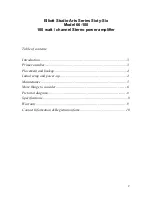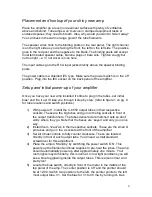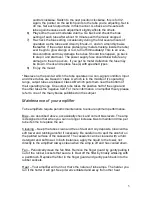
4
Placement and hookup of your shiny new amp
Place the amplifier on a level non-resonant surface with plenty of ventilation
above and behind.
Tube amps won’t survive in cramped equipment racks or
enclosed spaces; they need to breath. Also, why would you want to hide it away?
You can bask in the warm orange glow of the tube filaments.
The speaker wires hook to the binding posts on the rear panel. The right channel
is on the right side as
you’re facing the front, the left on the left side. The positive
goes to the red post and the negative to the black. The binding posts will accept
most terminated speaker cable, banana plugs or bare wire. Tighten snugly but
not too tight
– a ½” nut driver is nice here.
The input cables go to the RCA input jacks directly above the speaker binding
posts.
The power cable is a shielded IEC type. Make sure the power switch is in the
‘off’
position. Plug into the IEC socket on the back panel of the amplifier.
Setup and initial power-up of your amplifier
Once you have your new amp installed it’s time to plug in the tubes, set initial
bias* and fire it up!
I’ll take you through it step by step: (refer to figure 1 on pg. 8
for tube locations and switch positions)
1) With power off - Install the 4- 6550 output tubes in their respective
sockets. These are the big tubes and go into the big sockets in front of
the output transformers.
The tubes delivered are matched sets so don’t
worry where they go.
Note that the bases are ‘keyed’ and only go in one
way.
2) Install the 4-
12au7a’s in their respective sockets. These are the small 9-
pin tubes and go in the 4 sockets at the front of the amplifier.
3) Set all 4 bias controls to fully counter clockwise. These are located
directly in front of each output tube.
You’ll need a small standard
screwdriver for this adjustment.
4)
Place the amp in ‘Standby’ by switching the power switch ‘ON’. This
powers up the filament and bias supplies to pre-heat the tubes. The amp
should automatically power up after approximately one minute. Your
room lights may dim briefly, this is normal. In low light conditions you will
see a blue fog glowing inside the output tubes. This is also normal, and
pretty too!
5) Locate the bias switch, directly in front of the meter in the middle of the
top panel of the amp.
The center position is ‘off’ and the pointer should
be at 12:00. Switch two positions to the left, the pointer points to the left
most output tube, V1.
Set the bias for V1 to 40 ma. by turning it’s bias
Summary of Contents for 66-100
Page 1: ......










